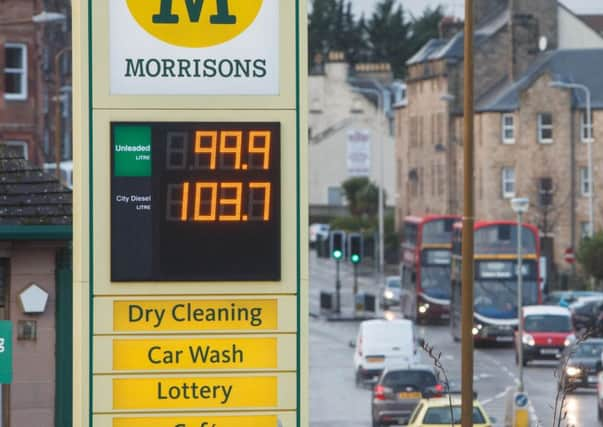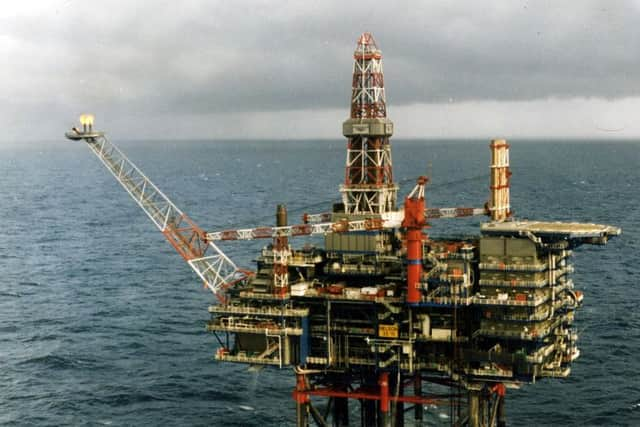Peter Jones: Crude facts about North Sea’s future


Driving around this Christmas, whether shopping or visiting friends and relatives, has one little festive bonus – petrol, if you buy at a supermarket which has dipped the price below £1 per litre, is now as cheap as it was in real terms (ie, discounting inflation) ten years ago when it was below 90p a litre.
It is also nearly 15 per cent cheaper than this time last year. Plus, this winter’s mildness (which is, for those of us concerned about climate change, troubling news), also means household spending on energy bills ought to be well down. Since the average working Scottish household spends about a fifth of income on home and transport energy, most Scots are now getting a bit of a financial windfall.
Advertisement
Hide AdAdvertisement
Hide AdWell, you might say, after half a decade of almost unremittingly bad financial news, which can hardly have left a single household unscathed, let’s raise a glass of cheer to that. And if there is any hangover guilty conscience to be assuaged, let’s deal with that in the New Year.


In fact, there will be more than some guilt to worry about. The cause of the spending bonus is, of course, the fall in the benchmark Brent crude oil price which, as I write, has continued to tumble to an 11-year low below $37 per barrel.
The slide began in 2014, falling off what now (when you look at a historical price chart) looks like a cliff edge of $113 a barrel in May to crash down to $50 a year ago. Then, knowledgeable industry folk in Aberdeen were expecting (or maybe just hoping for) a recovery by mid-2015 to around $60 a barrel, which indeed it did. For a while. But now it’s down again at two-thirds of the price which those industry folk said the North Sea industry could survive, albeit with some pain.
Is it going to recover any time soon? The question is extremely important because tens of thousands of Scottish jobs directly depend, and some further tens of thousands of income indirectly depend, on a profitable North Sea which, in 2014 and 2015, it has not been.
No industry, not even one which, before this price slump at least, had substantial cash reserves, can survive being loss-making for long. And even if the industry gets its average operating costs per barrel of oil produced down to £15 ($22 at current exchange rates) by the end of 2016, any oil price below $40 means precious little profit once other costs, such as the price of capital to develop an oilfield, are taken into account.
Remember too that as the price slump is worldwide (even around $1 lower in North America), cost-cutting is global. So our little corner of it, one of the most expensive producing provinces, is liable to remain at a cost disadvantage.
This severely handicaps efforts to attract the investment to develop the 9.5-16 billion barrels of oil equivalent in proven and potential additional reserves.
So, for a slimmed-down North Sea industry to not just survive but to have the healthy 25-40 years of life everyone hopes it will have, the price needs to rise. And while oil price forecasting is probably the best job anyone fond of egg-on-face could have, there are few signs of upward pressures.
Advertisement
Hide AdAdvertisement
Hide AdToday’s oil market is primarily driven by supply and demand – the speculative trading which mainly caused the temporary spike up to $147 a barrel in 2008 has mostly disappeared. So if supply falls or demand rises, then the price will go up and vice versa. Currently the global market consumes about 92 million barrels per day (bopd) but is over-supplied by about 1.25 million bopd, hence low prices.
Greater efficiency in the use of fuels and switching to electric or gas-powered vehicles has caused demand to drop in the developed world. Britain’s consumption of oil has dropped from 1.8 million bopd in 2005 to 1.5 million bopd in 2014. Up to 2014, this fall was more than outweighed by demand growth in developing countries, especially China.
But now world and Chinese growth has slowed and demand for oil is not rising so fast. City smog is forcing Chinese authorities to restrict car use and the Chinese government has become a lot more interested in vehicle fuel efficiency. These and other trends, such as rising popular support for measures to combat climate change, are causing some analysts to speculate that the world might be nearing a peak in demand for oil and the onset of a long-term decline in oil consumption. It is distinctly possible.
Might this also drive supply reductions? After all, if nobody is making much profit from oil production, what’s the point in investing in it? Saudi Arabia has been trying that for nearly two years now, aiming to keep OPEC’s production of 30 per cent of global oil supply at levels which will put US shale oil producers out of business.
But the reduction in US output has been much slower than expected. That’s because once money has been put into the ground, it has to be got out again, even if it is only 90 per cent of what has been spent. The same applies to recent expensive conventional fields, such as those west of Shetland, developed in high price days.
Meantime, the lifting of sanctions is widely expected to see Iran return to oil exporting, perhaps with 500,000 bopd, in 2016 and peace in Libya could add the same again. Of course, some unforeseen eruption, such as revolution in Saudi Arabia, could restrict supply and see prices shoot up.
All very unpredictable. But such are the financial pressures on oil producers – companies large and small, national producers from Russia to Algeria – that any substantial price rise would see a race to pump more to cash in, which would inevitably drive prices down again within a year.
Prices, I therefore think, are more likely than not to remain around the $40 mark. There will be up and down swings, but market forces will keep dragging it back to that level, a dismal prospect for the North Sea industry and almost as bleak for Scotland’s economy. Otherwise, seasonal best wishes, and happy, cheap, and safe festive motoring, to all readers.